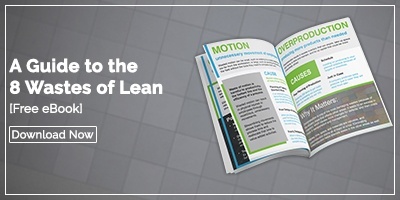 Ecologists and other environmentally aware people often talk about the goal of "Zero Waste." But, of course, that's an outstanding goal for business as well.
Ecologists and other environmentally aware people often talk about the goal of "Zero Waste." But, of course, that's an outstanding goal for business as well.
Reducing waste is at the heart of the Lean business methodology. The purpose of Lean is to spend more of your time creating value for customers by reducing or eliminating everything that does not produce value (AKA the waste). Value can take the form of finished goods, services, or information. To make it easier to identify waste in business processes, Lean practitioners target eight specific types of waste.
Although the Lean approach originated in manufacturing, it is used in almost every sector. Strikingly the eight wastes are common across industries, including software development, construction, healthcare, and education. Although it is not as apparent as it may be on a factory floor, the set of tasks and activities performed in any sector creates a production process that ultimately provides value to a customer.
While some of the wastes are self-explanatory, others are more difficult to recognize. This post aims to help by giving a few examples of each type of waste in various businesses. Hopefully, they will help you think about how waste may be occurring in your operations and how to begin designing processes that minimize it. Of course, the people who are most likely to find and correct waste are the process operators, so it is a good idea to share these examples with them and provide a way for each employee to submit opportunities for improvement.
Defects/Mistakes
This waste is related to the time and materials spent doing something of poor quality and later fixing it or trashing it. Lean practitioners also count the inspection cost as part of this waste (although you shouldn't reduce inspection unless you've created perfect quality through mistake-proofing techniques). Here are some examples:
- Administering incorrect medication or doses to patients
- Manufactured parts that don't pass inspection
- Software bugs
- Incorrect data entry
- Deliveries with missing or wrong items

Transportation
The waste of transportation involves moving inventory, people, tools, or other items more often or further than is necessary. Excessive movement can lead to product damage, unnecessary work, and exhaustion. Examples of transportation waste include:
- Moving hospital patients from department to department
- Sending overstocked inventory back to a warehouse or an outlet store location
- Transportation of products from one functional area to another
- Inefficient delivery routes
Waiting
Waiting involves customers, patients, or inventory sitting idle. Waiting happens when the person or item is ready for the next step, but the process is not prepared to accommodate them. Here are some examples:
- Patients in waiting rooms
- Software sitting in the QA queue
- Waiting for responses from other departments
- Manufacturing processes waiting for component delivery
- Shared driving service cars waiting for a passenger assignment at the airport
Motion
The waste of motion involves the unnecessary movement of people or items within a work center. It is often the result of neglecting the 5s'. Here are some examples:
- People searching for materials, tools, or equipment
- Poorly structured or disorganized workspaces
- Unnecessary meetings
- Having to make too many clicks on a website or software to accomplish a small task
Overproduction
Producing more of a product than can be consumed at the time creates the waste of overproduction. Making too much of something (or making it too early) creates other types of waste. Overproduction is of particular concern because it exacerbates transportation, inventory, and motion wastes. Examples include:
- Production of components before the next stage in the process is ready to receive them
- Printing and filing of unnecessary documents
- Creation of meals that are not eaten or partially eaten
- Cars that sit unsold in a car dealer lot
- Hollywood making a movie that virtually nobody goes to see
Over-processing
Over-processing means doing work that does not add value to the customer. Over-processing is resolved with simplification. Sometimes, in Lean, the best approach is to stop doing some things instead of figuring out how to do them better.
- Entering the same data in more than one place on a form or in a software application
- Multiple approval levels for a small spending request
- Ordering unnecessary tests for patients
- Extra report information
- Product features that no one uses
Inventory
The waste of inventory involves storing products or materials that are not needed. Excess inventory results in a waste of space, and it wastes the cost associated with the physical inventory. Although it is a significant concern in manufacturing, it occurs in other sectors as well.
- Excess production of promotional materials or printed forms
- Cabinets full of office supplies
- Produce or food that is not used by the expiration date
- Kitchen gadgets that are accumulated and not used
- Unused or rarely used equipment
- Data entry piling up
Human Potential
For a long time, the discussion centered around only the prior seven Lean wastes, but more recently, the waste of human potential has joined their ranks, and with good reason. It is probably the most common and most damaging type of waste that organizations encounter. You see it when:
- Employees spending time on tasks that do not add value
- Career development and planning are absent
- People with advanced skills doing routine work
- Employee ideas for improvement that are ignored
The Lean Wastes and COVID-19
The COVID-19 pandemic offers many insights into how waste impacts the critical healthcare needs of millions of people.
An early example of the waste of defects occurred when Johnson & Johnson had to discard a batch of its COVID-19 vaccine due to contamination with another company's vaccine. Fortunately, the error was caught during an inspection, but millions of doses were wasted.
Eliminating inventory waste has been a crucial goal of public health experts. Every dose of the vaccine delivered to a location where it can't be used due to lack of a distribution infrastructure or lack of demand represents a missed opportunity to keep someone healthy and slow the spread of the virus.
There have been some bright spots as well. The shift to remote work and online healthcare has enormously impacted transportation waste over the last two years. Every skipped trip into the office represents potential savings in gas, parking, tolls, public transportation fares, and wear and tear on vehicles.
Software Assisted Waste Reduction
Continuous improvement software can significantly affect organizations serious about finding and eliminating waste in all of its forms. Here's how it helps:
Capture Opportunities for Improvement
The first step in eliminating waste is identifying it. Continuous improvement software makes it easy for everyone who spots waste to document and report it. These opportunities reside in one central system, giving managers an easy way to prioritize them for action. The best solutions are user-friendly and available on mobile devices so that people can capture them without interrupting their regular workflow.
Document and Share Standardized Work
A critical element of waste reduction is Standardized Work. Standard work represents the current, least wasteful best practice for any activity or task. Process operators adhere to the Standard until it is revised through an improvement cycle. Improvement software makes it easy to create, share, and access Standard work documents.
Enhance Cross-Functional Collaboration
Many organizations find that most waste occurs at the points in a process where different functions intersect. Breakdowns that result in waiting, wasted motion, and unnecessary movement are common when handoffs occur. That's why getting all departments on one system to manage improvement and problem-solving is critical. When everyone is on a single platform, communication flows smoothly, and improvement gains momentum. Everyone speaks the same language and follows a standard procedure for planning, implementing, and evaluating their improvements.
Ensure Forward Progress
We've talked to a few leaders who insist that spreadsheets are sufficient for managing efforts to attack the eight Lean wastes, but none who can show significant results from this approach. The problem is that spreadsheets are passive. They require someone to remember to access them and take action. On the other hand, improvement software is equipped with alerts and notifications that pull people back to the task at hand. It also ensures that managers have visibility into each project's progress and can remove roadblocks should they occur.

Measures Results
Organizations decide to take on the eight wastes of Lean to achieve specific results. However, without a software solution in place, it can be challenging to measure and report the impact of waste elimination. The best solutions make it easy for leaders to calculate how improvement has reduced costs, speed time to market, impacted customer satisfaction, and improved profitability.
Recognize and Reward Success
One way to maximize the use of human potential within an organization is to recognize and reward employees who engage in improvement and waste reduction. Acknowledging this effort will encourage the team member to continue to work toward positive change, and it will encourage others to get involved. The best software solutions make it easy to broadcast success and reinforce the importance that leadership places on this work.
We want to challenge you to find specific examples of each of the eight wastes of Lean within your organization. Some may be glaringly obvious, while others are more subtle and harder to find. When you identify waste, you also uncover opportunities for improvement and move closer to becoming a more efficient and cost-effective organization.


Add a Comment